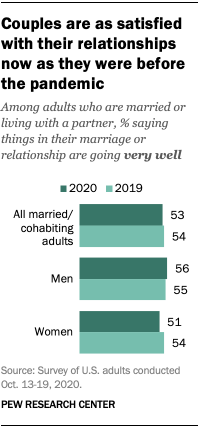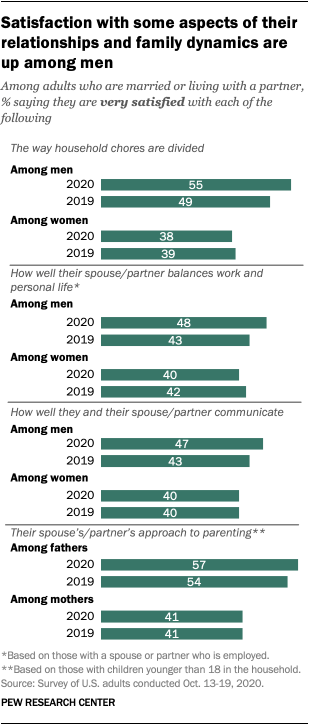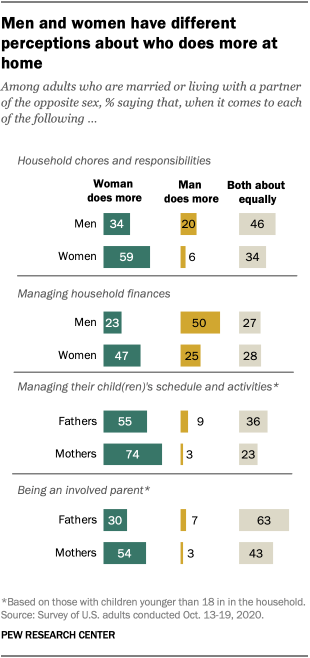The COVID-19 pandemic has changed nearly every aspect of American life, including how people work, get an education, connect with their family and friend networks and fill their social calendars. Despite quarantine orders that forced many people to stay home and spend more time with their families, a new Pew Research Center analysis of October 2020 survey data finds that many of the dynamics between couples haven’t changed much during this turbulent time.
At the same time, there has been a change in how some parents feel about the amount of time they spend with their children. Specifically, fathers are now more likely to say they spend the right amount of time with their children than they were before the pandemic, when a majority said they spent too little time.
Pew Research Center conducted this study to better understand how U.S. adults who are married or cohabiting assess their relationship with their spouse or partner amid the coronavirus outbreak and how the sharing of household responsibilities has (or has not) changed among couples from pre-pandemic times.
This analysis examines married and cohabiting adults, and in some cases those who have children younger than 18 living in their household. It is based on three nationwide surveys conducted Oct. 13-19, 2020, among 10,332 U.S. adults; June 25-July 8, 2019, among 9,834 U.S. adults; and Aug. 8-Sept. 28, 2017, among 4,573 U.S. adults. Everyone who took part is (or was) a member of the Center’s American Trends Panel (ATP), an online survey panel that is recruited through national, random sampling of residential addresses. This way, nearly all U.S. adults have a chance of selection. The survey is weighted to be representative of the U.S. adult population by gender, race, ethnicity, partisan affiliation, education and other categories. Read more about the ATP’s methodology.
Here are the questions used for this report, along with responses, and its methodology.
Among all married or cohabiting adults, 53% say things in their marriage or relationship currently are going very well, while an additional 37% say things are going fairly well. Roughly one-in-ten (9%) say their relationship is going not too or not at all well. These shares are virtually unchanged from a Pew Research Center survey conducted in 2019, well before the coronavirus outbreak started. Men remain somewhat more likely than women to rate their relationship positively.
While assessments of overall relationship satisfaction haven’t changed among either men or women, men are more likely than they were before the pandemic to say they are satisfied with at least one aspect of their relationship with their spouse or partner: how household chores are divided.
In 2019, married and cohabiting men (49%) were more likely than their female counterparts (39%) to say they were very satisfied with the way household chores are divided between them and their spouse or partner. That gap has grown in 2020: As of October, 55% of men say they are very satisfied with this aspect of their relationship, compared with 38% of women.
Another area where gender patterns have shifted is in views about how well spouses or partners are balancing work and personal life. Among married or cohabiting adults with a working spouse or partner, men (48%) are more likely than women (40%) to be very satisfied with this aspect of their relationship. In 2019, men’s and women’s views on this did not differ significantly.
As was the case in 2019, men are more likely than women to be satisfied with their spouse or partner’s approach to parenting (57% of fathers vs. 41% of mothers are very satisfied) and with how well they and their partner communicate (47% of men say they are very satisfied compared with 40% of women).
Perhaps the most notable change in attitudes about family dynamics is in fathers’ assessments of the amount of time they spend with their children. As of October 2020, 46% of fathers report spending the right amount of time with their kids – a 10 percentage point increase from 2017. A similar share of fathers (48%) say they spend too little time with their kids, down significantly from 63% in 2017. Only 5% of dads say they spend too much time with their children.
Women’s views on this have not changed significantly. In the latest survey, 58% of mothers say they spend the right amount of time with their children, 28% say they spend too little time and 13% say they spend too much time with their children.
Long-standing gender disparities in the household division of labor – which have been well-documented – have persisted during the pandemic. The survey finds that, across a range of activities, married or cohabiting men and women in opposite-sex relationships have different perspectives on who shoulders more of the burden. A majority of women (59%) say they do more household chores than their spouse or partner, while 6% say their spouse or partner does more. Among men, a plurality (46%) say these responsibilities are shared about equally, while 20% say they do more and 34% say their spouse or partner does more.
The management of household finances is another area where perspectives differ significantly by gender. Some 47% of women say they do more of this than their spouse or partner, while 25% say their husband or partner does more. Men see things quite differently: 50% say they do more than their wife or partner in this area, while 23% say their spouse or partner does more than them. Gender differences in perceptions of how household chores and finances are divided were similar in 2019, suggesting these dynamics have changed little during the pandemic.
When it comes to child-rearing, women see themselves carrying a much heavier burden than their spouses or partners, while men are more likely than women to say responsibilities are evenly shared. About three-quarters (74%) of mothers say they do more to manage their children’s schedules and activities than their spouse or partner; only 3% say their husband or partner does more of this. Roughly half (54%) of mothers say they do more than their spouse or partner to be an involved parent, while just 3% say their spouse or partner does more.
Most fathers (63%) say being an involved parent is shared about equally between them and their spouse or partner, compared with 43% of mothers who say the same. Similarly, fathers are more likely than mothers to say managing schedules and activities is evenly shared. Among women, perceptions about this haven’t markedly changed over the past year.
Note: Here are the questions used for this report, along with responses, and its methodology.





